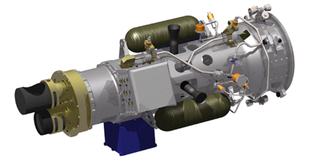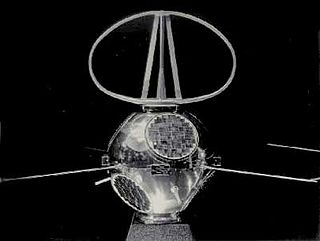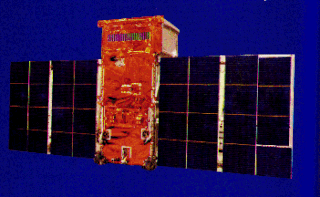Related Research Articles

The Explorers program is a NASA exploration program that provides flight opportunities for physics, geophysics, heliophysics, and astrophysics investigations from space. Launched in 1958, Explorer 1 was the first spacecraft of the United States to achieve orbit. Over 90 space missions have been launched since. Starting with Explorer 6, it has been operated by NASA, with regular collaboration with a variety of other institutions, including many international partners.
This timeline of artificial satellites and space probes includes uncrewed spacecraft including technology demonstrators, observatories, lunar probes, and interplanetary probes. First satellites from each country are included. Not included are most Earth science satellites, commercial satellites or crewed missions.
Project Vanguard was a program managed by the United States Navy Naval Research Laboratory (NRL), which intended to launch the first artificial satellite into low Earth orbit using a Vanguard rocket. as the launch vehicle from Cape Canaveral Missile Annex, Florida.
Shenzhou 2 launched on January 9, 2001, was the second unmanned launch of the Shenzhou spacecraft. Inside the reentry capsule were a monkey, a dog and a rabbit in a test of the spaceship's life support systems. The reentry module separated from the rest of the spacecraft after just over seven days in orbit, with the orbital module staying in orbit for another 220 days.

Spaceflight began in the 20th century following theoretical and practical breakthroughs by Konstantin Tsiolkovsky, Robert H. Goddard, and Hermann Oberth. First successful large-scale rocket programs were initiated in Nazi Germany by Wernher von Braun. The Soviet Union took the lead in the post-war Space Race, launching the first satellite, the first man and the first woman into orbit. The United States caught up with, and then passed, their Soviet rivals during the mid-1960s, landing the first men on the Moon in 1969. In the same period, France, the United Kingdom, Japan and China were concurrently developing more limited launch capabilities.

Kosmos 398 was the second unmanned test flight of the Soviet LK lander, using the T2K version. It followed the same program as Kosmos 379, launching on February 26, 1971 into a 276 km by 196 km orbit. It main objective was to validate contingency abort-to-lunar orbit manoeuvres.

AEROS satellites were to study the aeronomy i. e. the science of the upper atmosphere and ionosphere, in particular the F region under the strong influence of solar extreme ultraviolet radiation. To this end the spectrum of this radiation was recorded aboard by one instrument on the one hand and a set of 4 other instruments measuring the most important neutral uand iononized parameters at the satellite's position on the other.

XSS-10 was a small, low-cost micro-spacecraft developed by the U.S. Air Force Research Laboratory's Space Vehicles Directorate to test technology for line-of-sight guidance of spacecraft. The project was initiated at AFRL by Program Manager David Barnhart and completed by Georgia Tech Research Institute engineer Thom Davis and team. The project was declared a success shortly after launch.
Orion 3 was an American spacecraft which was intended for use by Orion Network Systems, as a geostationary communications satellite. It was to have been positioned in geostationary orbit at a longitude of 139° East, from where it was to have provided communications services to Asia and Oceania. Due to a malfunction during launch, it was instead delivered to a useless low Earth orbit.
Lewis was an American satellite which was to have been operated by NASA as part of the Small Satellite Technology Initiative. It carried two experimental Earth imaging instruments, and an ultraviolet astronomy payload. Due to a design flaw it failed within three days of reaching orbit, before it became operational.
Discoverer 20, also known as KH-5 9014A, was a USAF photographic reconnaissance satellite under the supervision of the National Reconnaissance Office (NRO) which was launched in 1961. Discoverer 20 was the first KH-5 ARGON satellite to be launched.

Transit 3B was an American satellite which was launched in 1961 and operated by the United States Navy. It was a replacement for Transit 3A, which was lost in a launch failure the previous year. It carried instruments to demonstrate navigation and timing systems, and study geodesy to support the development of the Transit satellite navigation system.

LOFTI-1 was an American satellite which was launched in 1961 and operated by the United States Navy and Naval Research Laboratory. It was used to conduct research into the propagation of very low frequency radio signals in the ionosphere, and to investigate if these signals could be received by submarines. A 136.17 MHz transmitter was used for this investigation.

TD-1A, or Thor-Delta 1A, was a European astrophysical research satellite which was launched in 1972. Operated by the European Space Research Organisation, TD-1A made astronomical surveys primarily in the ultraviolet, but also using x-ray and gamma ray detectors.
Kosmos 154, also known as L-1 No.3P, was a Soviet test spacecraft launched from the Baikonur aboard a Proton-K rocket. It was a prototype Soyuz 7K-L1 launched by Proton. It was an uncrewed precursor to the Zond series.
Tempsat-1 was a United States Navy Radar calibration object, launched from Vandenberg Air Force Base on a Thor Ablestar on August 13, 1965. It was a 14 inches (36 cm), unguided sphere. It was mainly used in investigation of spacecraft technology and orbits.
The Surveillance Calibration satellites were a series of radar calibration satellites for the Naval Space Surveillance radar system. They were launched in the 1960s.
References
- ↑ Romanova, N.; Crosby, N.; Pilipenko, V. (2013-05-28). "Relationship of Worldwide Rocket Launch Crashes with Geophysical Parameters". International Journal of Geophysics. 2013: e297310. doi: 10.1155/2013/297310 . ISSN 1687-885X.
- ↑ "table1.32". 2004-11-18. Archived from the original on 2004-11-18. Retrieved 2022-02-07.
- ↑ "table1.33". history.nasa.gov. Retrieved 2022-02-07.
- ↑ "NASA - NSSDCA - Spacecraft - Details". nssdc.gsfc.nasa.gov. Retrieved 2022-02-07.
- ↑ "Vintage ISEE-3 satellite makes long-awaited flyby on Sunday". Los Angeles Times. 2014-08-09. Retrieved 2022-02-07.
- ↑ "NASA - NSSDCA - Spacecraft - Details". nssdc.gsfc.nasa.gov. Retrieved 2022-02-07.
- ↑ "NSSDC Master Catalog Spacecraft Query Form". 1997-04-13. Archived from the original on 1997-04-13. Retrieved 2022-02-07.
- ↑ "History of the Delta Launch Vehicle". kevinforsyth.net. Retrieved 2022-02-07.
- ↑ "CNN - Unmanned rocket explodes after liftoff - Jan. 17, 1997". CNN. Retrieved 2022-02-07.
- ↑ "Delta". 2010-01-07. Archived from the original on 2010-01-07. Retrieved 2022-02-07.
- ↑ "Delta 6000". 2009-09-12. Archived from the original on 2009-09-12. Retrieved 2022-02-07.
- ↑ "Delta 7000". 2009-09-11. Archived from the original on 2009-09-11. Retrieved 2022-02-07.
- ↑ "Paul Maley's Satellite Page". 2005-02-27. Archived from the original on 2005-02-27. Retrieved 2022-02-07.
- ↑ "Unmanned rocket explodes after liftoff". CNN. 17 January 1997. Retrieved 2019-08-14.
- ↑ "Delta 3 rocket falls short but still a success, Boeing says". Spaceflight Now. August 24, 2000.
- ↑ "The DemoSat payload (Boeing Fact Sheet)". Spaceflight Now. 2004-12-01.
- ↑ Ray, Justin (December 22, 2004). "Delta 4-Heavy hits snag on test flight". Spaceflight Now.